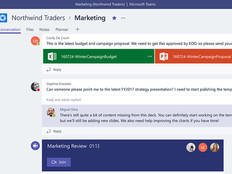Make the Most of Group Messaging Apps
Many organizations have embraced group messaging apps to bolster productivity and avoid unwieldy emails.
Some agencies have begun to experiment with this genre, known as enterprise social technology, as well. But before feds are ready to share documents, IT leaders should ensure that agencies get the most out of the applications.
Here are three tips to help agencies optimize group messaging.
1. Choose a Solution that Fits with Existing Software
If an agency has already invested in a productivity suite, such as Microsoft Office 365, IT managers should learn how the vendor’s chat and instant messaging products can integrate.
Microsoft Teams, which is the company’s answer to Slack, is already integrated with Office 365 and, as a result, may be easier to secure and manage. But unlike the popular Skype for Business, Teams doesn’t offer public switched telephone network calling or integration with Office 365 instant messaging via Outlook or SharePoint.
Another offering, Yammer, includes instant messaging, but Microsoft plans to integrate Yammer features with Skype for Business.
Cisco Spark relies on extensions to integrate with an agency’s system and offer users access to documents on the cloud. Those extensions also can help managers specify what files and documents are available to users.
2. Secure and Manage Group Chat Settings
Before adopting a group chat app, IT leaders should consider how their agencies will control user access and meet broader federal security requirements. Microsoft Teams provides the ability to manage access using Office 365 Groups and to control message deletion, which can help agencies meet federal retention guidelines. It also features policies that support access for external users and allow teams to integrate with other Office 365 apps and third-party systems.
Cisco Spark encrypts messages, files and space names on a user’s device before sending them to the cloud. It then keeps that information encrypted until it reaches the recipient. Spark also lets admins set roles for users as well as retention policies. This can include locking rooms, adding or removing participants, and deleting anyone’s shared messages and files.
3. Train Users to Communicate Clearly via Group Chat
Group chats offer the ability to set up conversations — sometimes called a team or channel, depending on the product — related to a specific subject. Train users that if they want to discuss a new project, they should start a new channel, or invite a new group of participants. This capability allows users to quickly switch to the subject they’re ready to work on when their workflow allows and maximizes efficiency.
It’s also worth teaching users how to format text to make channels more readable. Some programs use special characters before and after the text, almost like HTML tags, to control formatting, such as *bold*, _italics_ and ~strikethrough~. In other instances, users can quote text, set up polls or offer lists with the lightest of programming.









